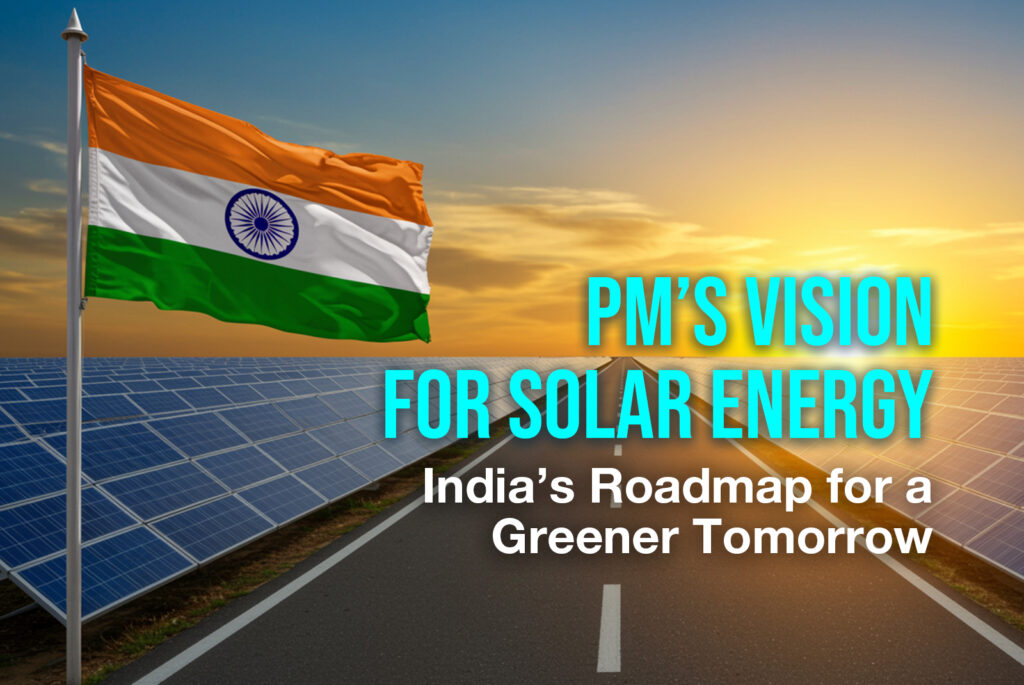Introduction: India’s Bold Solar Ambitions
India is at a crucial juncture in its transition toward a clean energy future. With the country facing increasing energy demands, rising pollution levels, and global climate commitments, the government has placed solar energy at the heart of its sustainability agenda. Prime Minister Narendra Modi’s vision for solar energy is deeply aligned with India’s broader goal of achieving energy independence and net-zero emissions by 2070.
From global initiatives like the International Solar Alliance (ISA) to ambitious domestic programs such as the PM-KUSUM Scheme and PLI incentives for solar manufacturing, the Indian government is aggressively pushing for a solar-powered revolution. But the question remains: Can India’s current roadmap lead to a truly green and sustainable future, and how does it compare with global efforts?
PM Modi’s Key Solar Energy Initiatives
The government’s strategy for expanding solar energy in India is built around three core objectives:
- Scaling up solar capacity to meet energy demands and reduce reliance on fossil fuels.
- Boosting domestic manufacturing to reduce import dependency and create jobs.
- Encouraging decentralized solar adoption to promote energy access across urban and rural India.
Some of the most significant policies and programs launched under PM Modi’s leadership include:
1. The International Solar Alliance (ISA)
Launched in 2015 at COP21 in Paris, the ISA is India’s global initiative to unite 121 sun-rich countries in scaling up solar deployment. The ISA aims to:
- Mobilize $1 trillion in solar investments by 2030.
- Establish common solar standards across member nations.
- Promote affordable solar technology transfer and financing.
India has taken the lead by committing $2 billion toward ISA-backed solar projects in developing nations. This initiative positions India as a global leader in renewable diplomacy, strengthening its role in climate negotiations.
2. 500 GW Renewable Energy Target by 2030
PM Modi announced at COP26 in Glasgow that India would achieve:
- 500 GW of non-fossil fuel capacity by 2030.
- 280 GW from solar alone, making it the largest contributor.
- A 50% share of renewable energy in total electricity consumption.
To meet this ambitious goal, India is rapidly expanding utility-scale solar parks while promoting rooftop and floating solar projects.
3. Pradhan Mantri-Kisan Urja Suraksha Evam Utthaan Mahabhiyan (PM-KUSUM)
The PM-KUSUM scheme is a revolutionary initiative aimed at solarizing India’s agricultural sector. It provides:
- Subsidies for solar-powered irrigation pumps.
- Incentives for farmers to generate and sell surplus solar energy.
- Support for setting up community solar farms in rural areas.
This program not only reduces farmers’ electricity costs but also lowers the carbon footprint of agriculture, one of India’s largest energy-consuming sectors.
4. Production-Linked Incentive (PLI) Scheme for Solar Manufacturing
One of the biggest challenges India faces is its dependency on Chinese solar imports. The PLI scheme, launched in 2021 and expanded in 2023, is designed to:
- Promote domestic manufacturing of solar PV modules.
- Reduce reliance on imported solar cells, wafers, and raw materials.
- Create over 100,000 jobs in India’s solar industry.
This initiative has already attracted major investments from companies like Reliance, Adani, and Tata Power, positioning India as a future solar manufacturing hub.
5. Green Hydrogen Mission: Solar-Powered Clean Fuel
The National Green Hydrogen Mission, announced in 2023, aims to:
- Produce 5 million metric tonnes of green hydrogen by 2030.
- Use solar energy to power hydrogen production, reducing carbon emissions.
- Establish India as a global hub for green hydrogen exports.
This initiative will integrate solar energy with industrial applications, making renewable energy more viable across sectors like steel, chemicals, and transportation.
Challenges Hindering India’s Solar Roadmap
Despite strong policy backing, India’s solar expansion faces multiple roadblocks:
1. Land Acquisition & Infrastructure Bottlenecks
- Large-scale solar projects require vast tracts of land, often leading to delays due to legal disputes and environmental concerns.
- India’s electricity grid needs modernization to handle fluctuating solar power efficiently.
2. Slow Growth of Rooftop Solar
- While utility-scale solar has grown rapidly, rooftop solar adoption remains low at just 6% of total solar capacity.
- Policy uncertainty around net metering and high upfront costs deter many households and businesses from installing solar panels.
3. Heavy Reliance on Imports
- Despite the PLI scheme, India still imports 75% of its solar panels and raw materials from China.
- High costs and lack of advanced technology hinder India’s ability to compete with Chinese solar manufacturing giants.
4. Financial and Policy Uncertainty
- Inconsistent solar policies across different states create uncertainty for investors.
- Funding for solar startups and projects remains limited, slowing innovation and deployment.
What Needs to Be Done: Strengthening India’s Solar Future
To accelerate solar adoption and overcome challenges, India must focus on:
1. Expanding Domestic Solar Manufacturing
- Strengthen the PLI scheme by offering long-term incentives for solar component manufacturers.
- Encourage private investment in R&D to develop high-efficiency solar panels and batteries.
2. Boosting Rooftop Solar Growth
- Simplify net metering regulations to encourage residential and industrial solar installations.
- Provide low-interest loans and better subsidies for rooftop solar consumers.
3. Strengthening Solar Infrastructure & Energy Storage
- Invest in smart grid technologies to improve solar energy integration.
- Scale up battery storage solutions to ensure round-the-clock renewable power availability.
4. Encouraging Public-Private Partnerships (PPP)
- Engage private sector companies in building large-scale solar parks.
- Promote solar-powered EV charging stations to link the solar and transportation sectors.
Conclusion: Can India Achieve PM Modi’s Solar Vision?
India’s solar energy revolution is gaining momentum under PM Modi’s leadership, with ambitious goals and massive investments in solar technology. However, to truly lead the global renewable energy transition, India must:
- Address infrastructure bottlenecks and accelerate domestic manufacturing.
- Enhance policy stability to attract long-term investments.
- Promote rooftop and decentralized solar adoption for energy security.
If India successfully navigates these challenges, it has the potential to not only meet but exceed its solar energy targets, making it a global powerhouse in renewable energy. The next five years will be crucial in determining whether India’s solar roadmap translates into tangible results, setting a precedent for emerging economies worldwide.

